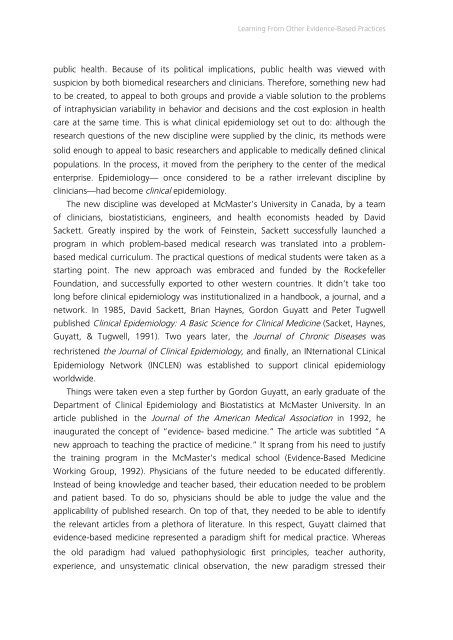In Search of Evidence
jqluvth
jqluvth
Create successful ePaper yourself
Turn your PDF publications into a flip-book with our unique Google optimized e-Paper software.
Learning From Other <strong>Evidence</strong>-Based Practices<br />
public health. Because <strong>of</strong> its political implications, public health was viewed with<br />
suspicion by both biomedical researchers and clinicians. Therefore, something new had<br />
to be created, to appeal to both groups and provide a viable solution to the problems<br />
<strong>of</strong> intraphysician variability in behavior and decisions and the cost explosion in health<br />
care at the same time. This is what clinical epidemiology set out to do: although the<br />
research questions <strong>of</strong> the new discipline were supplied by the clinic, its methods were<br />
solid enough to appeal to basic researchers and applicable to medically defined clinical<br />
populations. <strong>In</strong> the process, it moved from the periphery to the center <strong>of</strong> the medical<br />
enterprise. Epidemiology– once considered to be a rather irrelevant discipline by<br />
clinicians–had become clinical epidemiology.<br />
The new discipline was developed at McMaster’s University in Canada, by a team<br />
<strong>of</strong> clinicians, biostatisticians, engineers, and health economists headed by David<br />
Sackett. Greatly inspired by the work <strong>of</strong> Feinstein, Sackett successfully launched a<br />
program in which problem-based medical research was translated into a problembased<br />
medical curriculum. The practical questions <strong>of</strong> medical students were taken as a<br />
starting point. The new approach was embraced and funded by the Rockefeller<br />
Foundation, and successfully exported to other western countries. It didn’t take too<br />
long before clinical epidemiology was institutionalized in a handbook, a journal, and a<br />
network. <strong>In</strong> 1985, David Sackett, Brian Haynes, Gordon Guyatt and Peter Tugwell<br />
published Clinical Epidemiology: A Basic Science for Clinical Medicine (Sacket, Haynes,<br />
Guyatt, & Tugwell, 1991). Two years later, the Journal <strong>of</strong> Chronic Diseases was<br />
rechristened the Journal <strong>of</strong> Clinical Epidemiology, and finally, an INternational CLinical<br />
Epidemiology Network (INCLEN) was established to support clinical epidemiology<br />
worldwide.<br />
Things were taken even a step further by Gordon Guyatt, an early graduate <strong>of</strong> the<br />
Department <strong>of</strong> Clinical Epidemiology and Biostatistics at McMaster University. <strong>In</strong> an<br />
article published in the Journal <strong>of</strong> the American Medical Association in 1992, he<br />
inaugurated the concept <strong>of</strong> “evidence- based medicine.” The article was subtitled “A<br />
new approach to teaching the practice <strong>of</strong> medicine.” It sprang from his need to justify<br />
the training program in the McMaster’s medical school (<strong>Evidence</strong>-Based Medicine<br />
Working Group, 1992). Physicians <strong>of</strong> the future needed to be educated differently.<br />
<strong>In</strong>stead <strong>of</strong> being knowledge and teacher based, their education needed to be problem<br />
and patient based. To do so, physicians should be able to judge the value and the<br />
applicability <strong>of</strong> published research. On top <strong>of</strong> that, they needed to be able to identify<br />
the relevant articles from a plethora <strong>of</strong> literature. <strong>In</strong> this respect, Guyatt claimed that<br />
evidence-based medicine represented a paradigm shift for medical practice. Whereas<br />
the old paradigm had valued pathophysiologic first principles, teacher authority,<br />
experience, and unsystematic clinical observation, the new paradigm stressed their


